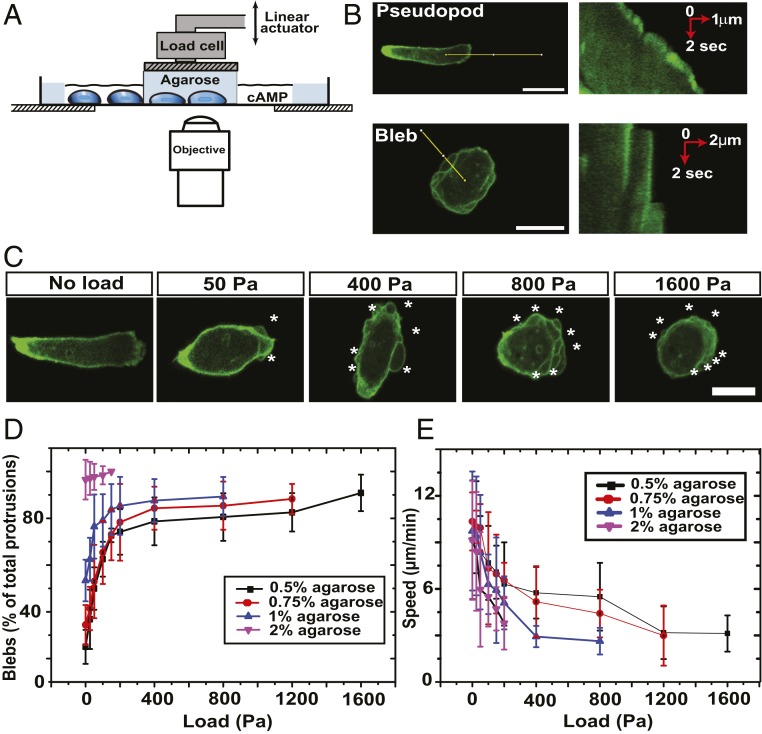
Citation
N. Srivastava, D. Traynor, M. Piel, A.J. Kabla, R.R. Kay
PNAS 117(5):2506-2512 (2020)
Abstract
Significance
Abstract
Significance
Cells migrating within the body perform vital functions in development and for defense and repair of tissues. In this dense environment, cells encounter mechanical forces and constraints not experienced when moving under buffer, and, accordingly, many change how they move. We find that gentle squashing, which mimics mechanical resistance, causes cells to move using blebs—a form of projection driven by fluid pressure—rather than pseudopods. This behavior depends on the Piezo stretch-operated ion channel in the cell membrane and calcium fluxes into the cell. Piezo is highly conserved and is required for light touch sensation; this work extends its functions into migrating cells.
Summary
Blebs and pseudopods can both power cell migration, with blebs often favored in tissues, where cells encounter increased mechanical resistance. To investigate how migrating cells detect and respond to mechanical forces, we used a “cell squasher” to apply uniaxial pressure to Dictyostelium cells chemotaxing under soft agarose. As little as 100 Pa causes a rapid (<10 s), sustained shift to movement with blebs rather than pseudopods. Cells are flattened under load and lose volume; the actin cytoskeleton is reorganized, with myosin II recruited to the cortex, which may pressurize the cytoplasm for blebbing. The transition to bleb-driven motility requires extracellular calcium and is accompanied by increased cytosolic calcium. It is largely abrogated in cells lacking the Piezo stretch-operated channel; under load, these cells persist in using pseudopods and chemotax poorly. We propose that migrating cells sense pressure through Piezo, which mediates calcium influx, directing movement with blebs instead of pseudopods.
Figure sample

Uniaxial load causes cells to move using blebs instead of pseudopods. (A) Diagram of the cell squasher used to apply uniaxial loads to cells moving under an agarose overlay (36). The load is applied using a plunger on the bridge between two wells cut into the agarose, one containing cells and the other, the chemoattractant cyclic AMP, which attracts the cells under the agarose toward it. (B) Distinction between pseudopods and blebs. At the Left are shown cells expressing an F-actin reporter, and at the Right, kymographs taken along the lines indicated at the Left. (Scale bar: 10 µm.) (C) Uniaxial load causes cells to migrate using blebs. The cells are migrating under an overlay of 0.5% agarose to which increasing uniaxial loads are applied. Blebs are indicated by white stars. (Scale bar: 10 µm.) (D) Blebbing of migrating cells increases with increasing load or overlay stiffness. (E) Cell speed decreases under increasing load or stiffness of the agarose overlay. The data are represented as mean ± SD for n ≥ 30 cells for each case with measurements made for about 30 min, starting 8 to 10 min after load was applied. The stiffness of the agarose overlays is as follows: 0.5% = 6.6 kPa; 0.75% = 11.9 kPa; 1% = 20.5 kPa; and 2% = 73.6 kPa. Aggregation-competent Ax2 cells expressing the ABD120-GFP reporter for F-actin and migrating toward cyclic AMP in KK2MC are used throughout.

